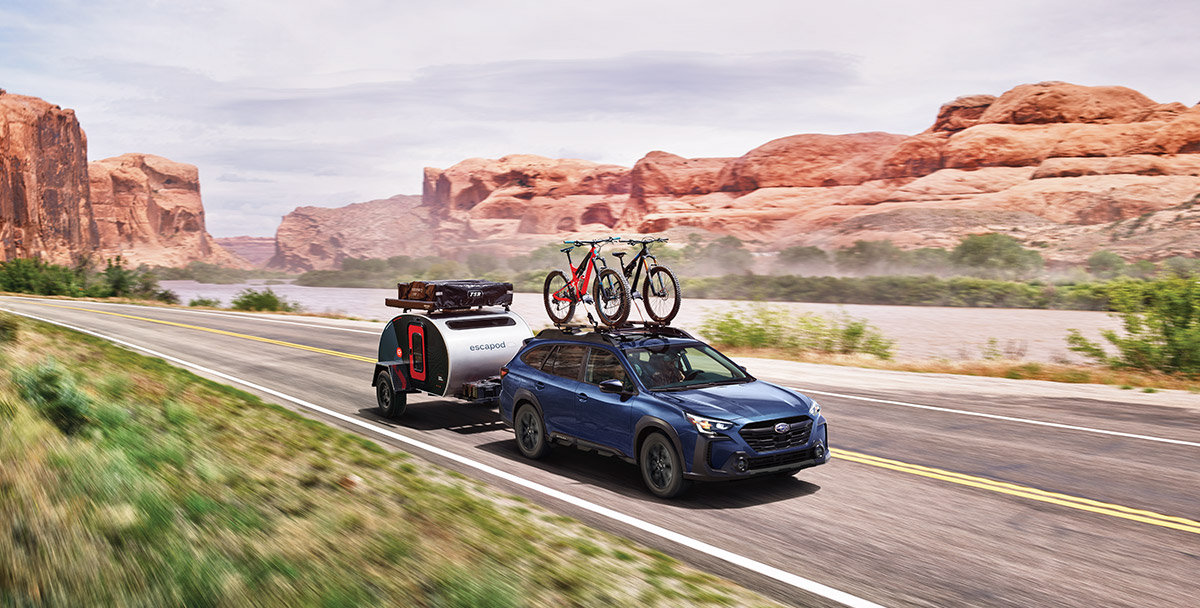Whatever the condition of your tires, there are some relatively inexpensive – or even free – ways to prolong their life and keep your Subaru as safe as possible, especially as colder weather arrives.
Check Your Tire Inflation
Ensuring that your tires are properly inflated is the least expensive, most beneficial bit of maintenance you can perform yourself. All it takes is a tire gauge. We like digital tire gauges because they’re more accurate and available at any parts or big-box hardware store for less than $15.
Check your tire pressure before you’ve driven anywhere – tires heat up from driving, which may cause an inaccurate reading.
Always set your tire pressure based on the placard affixed to the driver’s side door jamb of your Subaru model. Note that the inflation recommendation may change front to rear depending on how many passengers or how much cargo you’re carrying.
Keep in mind that vehicle tire pressures can lose up to one pound per square inch for every 10-degree drop in temperature (and vice versa), so what may have been properly inflated in mid-August can be underinflated on the first cold morning, setting off the Tire Pressure Monitoring System in your Subaru vehicle.


How Old Are Your Tires?
On every tire sold in the United States since 2000, the sidewall has a four-digit date code. These codes begin with the letters DOT, followed by a string of numbers. The only numbers you need are the last four, which reveal the week and year your tires were produced.
For example, if the DOT code has the numbers “1521,” it indicates that your tires were produced in the 15th week of 2021 or the week beginning April 12 that year.
Yokohama® is the tire supplier for many vehicles in the Subaru lineup, and its recommendation on replacement is 10 years or more from the date shown on the sidewall, regardless of tread depth.
How Worn Are Your Tires?
Radial tires made in the last three decades have a tread wear indicator molded right inside the tread to make it easier to determine when it’s time for replacement. When the tread wears to the point that it’s flush with the tread wear indicator, you have approximately 2/32 inches of tread left, which the manufacturer suggests is beyond the usable life of that tire.
In recent testing, though, Tire Rack® has determined that stopping distance is greatly increased on wet or slushy roads when tires are worn flush with the wear bars. By measuring the stopping distances from vehicles traveling 70 miles per hour, they found that those “equipped with the 2/32" minimum tire tread depth took about 100 more feet to stop.”
With the average car length at 14.7 feet, that 2/32" difference equals almost seven cars. “If rain and wet roads are a concern, you should consider replacing your tires when they reach approximately 4/32" of remaining tread depth,” Tire Rack advises.

The Importance of Tire Rotation
Your Subaru maintenance schedule in your Owner’s Manual has a tire rotation recommendation. Tire rotation helps to distribute wear evenly across all tires.
Be sure to check the specific rotation guidelines for your model, but in general, the Owner’s Manual recommends a tire rotation at 6 months or 6,000 miles, whichever comes first.
Is Wheel Balancing Important?
Another way of not only extending the life of your tires but also your suspension components is to make sure that your tires are properly balanced. Wheel balancing usually occurs simultaneously with tire replacement, but if you’ve felt unusual vibration in the steering wheel or the seat, it’s always appropriate to have the wheels balanced.
When Was Your Last Alignment?
Wheel alignment is key to keeping your tires from wearing out prematurely. A four-wheel alignment will reset the camber, caster and toe of your wheels back to the original specifications from Subaru.
Wheels can be knocked out of alignment by hitting potholes or curbs, or they can simply become misaligned because suspension components have worn out.

Don’t Forget Your Spare
If your Subaru model has a spare tire – some models or trim levels may have a tire inflation kit in lieu of a spare wheel and tire – it’s important to inspect it the same way you do the tires on the car. Check the date code, and make sure that it’s properly inflated on the same schedule as the rest of the tires.
If you have an Outback Wilderness or a Forester Wilderness with a full-size, matching spare tire and wheel, talk with your Subaru retailer to have it rotated along with the other four tires and wheels.
Your tires are the most important component to your safety on the road. They withstand daily assaults from temperature, friction and UV exposure, but by following these recommendations and talking with your Subaru service advisor, you’ll get the most life out of your investment.





